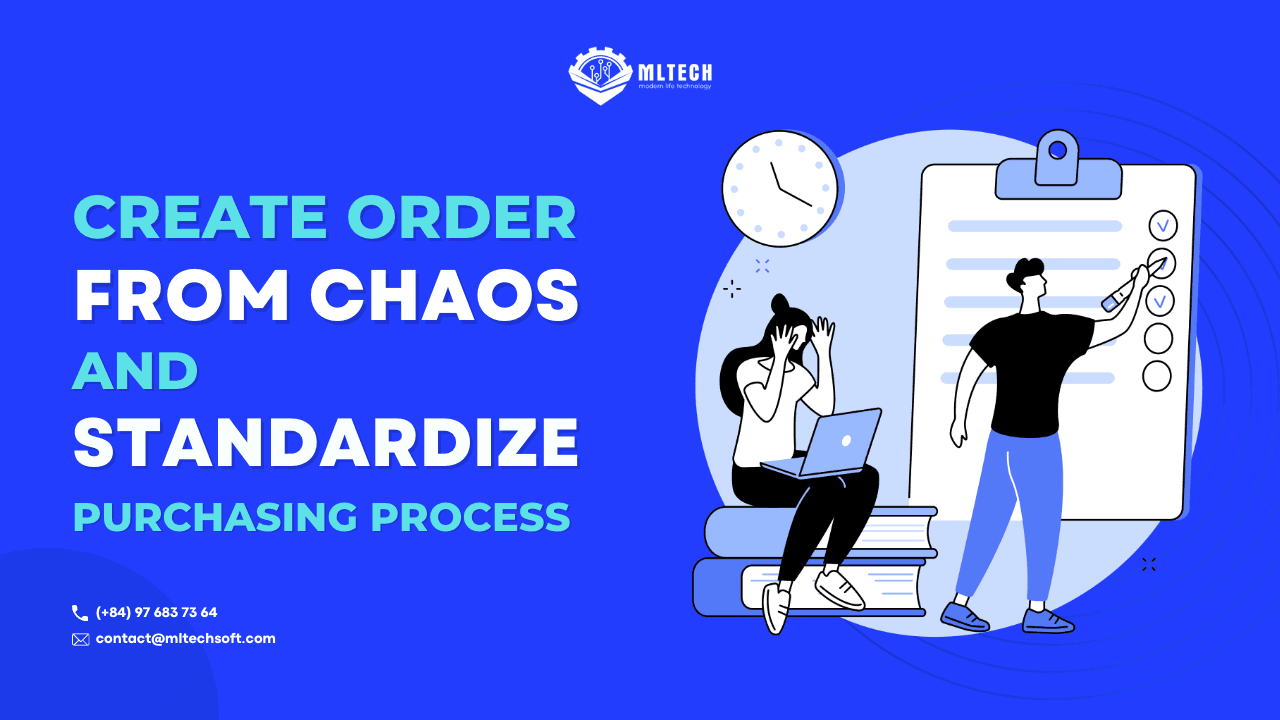Scroll down for more
Create Order from Chaos and Standardize Purchasing Process

All businesses need to purchase goods and services to meet their daily needs. If you have no formal way to purchase goods and services, you may be spending more than you should. Start the purchase process here.
How you set up your buying process has a huge impact on your business, not only in terms of managing costs and expenses but also in terms of how well it works. By learning a few steps and best practices and applying them to your buying process, you can reduce waste and protect your business from unnecessary risk and expense. You can also create workflows that make the most of every dollar spent in terms of efficiency, profit, and repeatability.
The benefits of standardizing your purchasing process include:
Process standardization is essential for high-performance supply chains. According to Learn G2, 79% of companies with supply chain management systems achieve higher revenue growth than those without optimization plans. You can serve your customers better while reducing costs across the chain. In an industry where lean, fast, and transparent are the three pillars, system standardization is essential for high performance.
Some of the advantages of standardization include:
- Merchandise turnover is fast
- Higher revenue generation
- Reduce resource waste
- Cost reduction
- Increased return on investment (for all partners)
- Increased productivity across the chain
- Reduced errors, losses, and delays
- Improving procurement and purchasing power
- Centralized communication
One of the most valuable benefits of supply chain standardization is the increased potential for collaboration. Using standard procedures and metrics can greatly improve the transparency of your supply chain, making it more efficient and effective.
Organizations that implement supply chain standardization say it essentially creates a “self-running” chain. This allows logistics managers to focus on high-level strategy, development, problem-solving, and networking instead of wasting time on day-to-day operations.

Identifying areas for improvement
First, look at the standards that are common and required in the industry. What laws and regulations must you follow to be compliant? What other standards are not required in your industry but are highly regarded?
Second, look at your company's unique plans. We suggest that you do a thorough review of your organization and supply chain to find out where you are right now and show that you are looking ahead.
Consider supply management systems, stakeholders, communication frequency, communication modes, and technology. Most importantly, consider your organization's goals and use standards to achieve those goals. For example, if your organization takes occupational safety seriously, you should consider how to implement new health and safety standards.
Remember, no company is an island. To ensure consistency and coherence, supply chain partners should participate in standardization. First, think about focusing your attention on optimizing your supply chain network to make it easier for partners to share information and talk to each other.
Developing a Standardized Process
In the past, we were content to just update the process once a year. Today, however, all processes must be reviewed at least every six months, if not every three months, to make sure they are up-to-date and working well. This is because technology has changed, there is more competition, and customers want things right away. must be maintained.
The task of going through all the processes to improve them may seem daunting at first. be patient. Doing this in the same way every time makes the whole organization more efficient and frees you from the headaches your current processes cause.
Start the standardization process where you care
It's okay if you can't say exactly why it bothers you at first. Trouble itself indicates that something is not working properly or is not a good fit for your company. This irritation helps motivate you to succeed.
If nothing immediately annoys you, look at what seems to be the least efficient or what's not working well. Or, even better, ask a team member. They'll probably quickly tell you what's working well and what's highly inefficient. Define the goals and objectives of the standardized process.

Create a purchasing policy
Purchasing policies remove ambiguity when purchasing products and services from vendors.
For small businesses, purchases are handled by very few people. So they already have common norms and probably don't need a written policy.
However, this approach won't work if your company grows from a few employees to many or multiple locations.
Without establishing a purchasing policy from the beginning, each department's process evolves. As the company continues to grow, these individual policies become the new norm, and integrating them into a consistent policy becomes difficult, if not impossible.
If you have purchased policies from the start, you can set default policies in various places.
As your business grows, you can update your purchasing policies to meet the specific needs of your location or department.
Standardize forms and documentation
This process includes recording and documenting all phases of a business operation or task. Documentation is provided on an ongoing basis as a means of correcting and identifying limitations and errors encountered in each operation. At this stage, you can cut unnecessary costs and work on productivity while ensuring quality products and services.
Documents can take on new forms depending on the complexity of the operation. More tasks need to be documented, requiring more resources. Ensure smooth and efficient operation.

Documentation is essential for process standardization. This will give you an idea of the individual steps to reach your end goal. Whenever workers need to perform similar operations, they know very well what to do and where to get them.
Records can be stored on a cloud platform where data can be accessed anytime, anywhere.
Implement and Maintain the Standardized Process
Standardization can be applied to any process, procedure, or task critical to your business. Processing payroll and bills, answering phone calls, and gathering customer information are examples of standardization. Each facility has its own approval criteria. The manager's job is to ensure that each team member is aware of and follows standard operating procedures.
Communicate the new process to stakeholders
Use these steps to actively engage key stakeholders early and regularly.
Prioritize stakeholders: Before you can begin engaging and communicating with your stakeholders, you must first identify who they are: those who control change, those who may resist change, and those who care about the consequences. Consider both insiders and outsiders.
Understanding stakeholders and their resistance on its own: The next step is to assess how each group of stakeholders reacts to and feels about the change so that you can communicate effectively.
Communication with Stakeholders: When making changes, you should communicate regularly with stakeholders to address any unanticipated issues or concerns. Communication with stakeholders should be based on the three main phases of change management.

Use a mix of communication channels: It is important to figure out how stakeholders want to get information and messages about changes. Each interest group has its own preferences for these channels.
Providing training and support
Policies and procedures are very important because they help businesses meet legal requirements and limit their liability. However, they also have a lot to offer when it comes to training employees. It is also important for promoting a culture of safety in the workplace and providing standards that all employees can follow.
Implementing the new process
Set clear goals: Any company would like to do well. This is understandable, but not a clear goal. Creating a goal statement makes it clear what the company wants to achieve. You should clearly define the business process that needs updating and why it needs to be done to meet your business goals.
Allocate appropriate resources: This cannot be overemphasized. If you don't take the time to plan properly, it will harm your business and your employees. You don't want to be in a situation where you don't have the resources to change the process. Make sure you have enough money and a reasonable amount of time to create and implement new procedures so that your team can finish the job.
Communicate the process clearly: Always explain the value the new process will bring to the organization and relevant departments. Make sure each step is clear and people understand what they need to do. Existing business documentation facilitates the replication of processes and establishes clear responsibilities and expectations.
Reviewing and updating the purchasing process:
The buying process is important because it provides a structured way for businesses to meet their needs. It can also help you make more informed financial plans. An effective purchasing process requires documentation of all commercial transactions, which helps prevent theft, fraud, and irregular spending.
Addressing issues and concerns:
Consciously decide how you will react to conflict situations. Most people remember how they reacted to a situation more than what happened. Although we often have no control over many situations, we can choose how we respond to others to reduce conflicts and stress at work. You accept responsibility for your actions.
Recognize that other perspectives are possible and likely. You may look at the situation differently, but the other person's feelings are genuine and legitimate. Denying their existence can escalate the situation. It's hard to find a solution without agreeing on the problem. If you don't understand the other person's point of view, you may not be able to resolve the right issues, and the conflict will get worse.
Brainstorm creative options. By getting other people involved in solving a problem, you can get their support and build stronger working relationships. Being open to solutions opens up a universe of comfort.
Conclusion
Compared to before, procurement has proven to be an important long-term and tactical function for companies. Of course, every business has different procurement needs that require different types of procurement processes. But the steps described here can make the whole process of getting things a lot more efficient.
Get our blog
Want the latest and greatest from our blog straight to your inbox? Chunk us your details and get a sweet weekly email.
Read more in our blog

Project Management
The Impact of Dynamic Pricing on Customer BehaviorExplore the impact of dynamic pricing on customer behavior and learn how to implement effective pricing strategies.

Project Management
Focus in Scrum: Keeping Your Team on TrackDiscover effective strategies to maintain focus within your Scrum team, overcome common challenges, and boost productivity.

Project Management
Key Metrics for Mobile App SuccessDiscover the essential metrics for mobile app success, from user acquisition and engagement to monetization and performance.
MLTECH SOFT